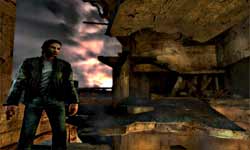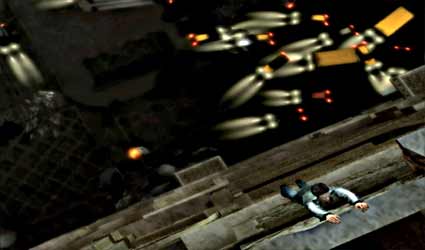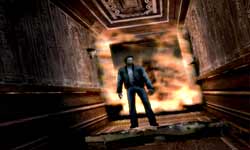When a game gets released for the Wii as well as the other current-generation consoles, nobody really expects an identical experience. Whether as a result of the addition of motion-sensing controls or the less powerful hardware, multiconsole games are usually quite different on the Wii. Despite many having somewhat lowered expectations for Wii versions of multiconsole titles, there are still plenty of reasonable things expected from almost any good game.

One would likely assume most competent games would look decent, have a slightly entertaining storyline, control well, and actually be somewhat fun to play. Unfortunately, Alone in the Dark (AITD) for the Wii manages to miss every one of these marks by fairly sizeable margins.
Darkness would appear to be this game’s greatest ally, as its poor graphics can be downright terrifying. Most of its backdrops are incredibly simplistic looking with repetitive, drab textures and an awful amount of pop-up to boot. Finding your way around this game’s environments can be challenging enough, but when everything looks incredibly similar, it can quickly become quite irritating. AITD’s characters don’t fare much better, looking like they came straight out of a Dreamcast title. Enemies, friends, and even the game’s main character, Edward Carnby, all appear rather jagged and severely lack detail. Even in its many included cutscenes, this game’s visuals still manage to appear incredibly dated.
Regrettably, the story that unfolds in these cutscenes does little to make them any easier to stomach. The concept behind the game initially sounds great, with Edward Carnby waking up in New York several decades in the future without aging and having no memories of his past. Central Park has essentially become hell-on-earth and Carnby must try to stay alive long enough to unravel what has happened and attempt to fix it. While many things are explained by the end of this game, the story clearly doesn’t resolve itself. Instead of leaving me pondering this game’s events or hoping for a sequel to further enlighten me, AITD’s story just left me feeling cheated in the end.

Continuing to burglarize players’ chances at an enjoyable experience with AITD is its atrocious gameplay. Ridiculously bad Wii controls collide with poor camera options to create one of the most frustrating experiences currently available. While progressing through the game, you will be able to control Carnby in both third and first-person perspectives. Usually the choice is yours, but frequently the game will actually force players into the first person view. In third person, the camera seems to be in a constant struggle to give you a workable angle of the action. Moreover, with no second analog stick to move the camera, a limited ability to re-center it, and the inability to use firearms combine to make this view virtually unusable.
The first-person perspective doesn’t help matters much either, having players move with the analog stick while turning and looking around are handled by pointing the Wii-mote. This view feels incredibly clumsy and doesn’t allow for a full range of vision. While exploring in this perspective, players will quickly realize they are unable to see above or below themselves very well. Players are sadly limited to a very small window in which they can actually view their surroundings. This becomes quite problematic, as you will frequently need to find ledges, holes, and platforms that tend to appear just outside of this limited window of vision. Prepare to get lost often as a direct result of these subpar camera options (even in this game’s extremely linear levels).

Nearly broken Wii controls only further exacerbate these issues, making even the simplest of tasks a chore. Motions are required for virtually every aspect of this game from opening your inventory to equipping your pistol. Major control problems quickly arise because of just how similar all these motions are and how badly the game registers them. The difference between pulling out a pistol, jumping, opening your inventory, and equipping a flashlight are somewhat slight and the game often doesn’t successfully differentiate between them. This typically results in a very angering experience complete with many cheap deaths directly caused by frequent misinterpretations of your movements.

Nowhere are AITD’s controls more painful than in its frequent driving segments. Here players will need to hold their Wii-mote and Nunchuk facing upwards and towards themselves, twisting both to the left and right to steer. Again, the game does an absolutely horrible job of actually picking up these motions, turning these portions into a test of the player’s patience and luck more than their skill. Since most of these driving segments also have no checkpoints throughout, repeated failures stemming directly from these terrible controls become increasingly more frustrating. Being forced to replay these sections multiple times from their beginnings is maddening, boring, and only further accentuates their many issues.
Unfortunately, battling this game’s camera and controls often proves more difficult than squaring off against any of its enemies. There are a few different enemies in the game, some requiring more work to dispatch than others. One enemy in particular forces you to hold down on the Wii-mote’s D-pad to make his constantly moving weak point visible. While some of these enemies can be a handful, it is frequently easier to just avoid these conflicts all together. Running past enemies is incredibly easy, as the A.I. in this game is virtually nonexistent. Several times while playing, I stood no more than three feet from enemies while they just stared blankly back at me. Foes’ sheer lack of effort when it comes to stopping Carnby leads me to speculate that they must clearly be getting paid by the hour and have no vested interest whatsoever in actually ending your quest.
While I may not have expected the same visual quality from the Wii version of AITD, the state in which this game was released is hard to believe. Almost every aspect of this game feels like it wasn’t clearly thought through and is certainly executed poorly. As a fan of the AITD series, I was really hoping this title would help to reestablish and ensure a bright future for this franchise. Unfortunately, if the Wii version of AITD is any indication as to where this series is headed, then nostalgia may be all that is left for its many fans.
RATING OUT OF 5 RATING DESCRIPTION 2.5 Graphics
While far from being the worst looking game on the Wii, AITD’s bland backdrops, ugly fire effects, and poor-looking characters do little to help out its visuals. 1.3 Control
Terrible motion detection combined with plenty of similar required movements results in a very frustrating experience that is easily at its worst when behind the wheel of a vehicle. 3.2 Music / Sound FX / Voice Acting
Interesting music and good quality, if not lifeless, voice acting makes AITD’s audio slightly better than average. 1.2
Play Value
Constant frustration, linear levels, infrequent checkpoints, a fairly short experience, and a disappointing finale, unfortunately, leave very few reasons other than nostalgia to actually play through this title.
1.6 Overall Rating – Avoid
Not an average. See Rating legend above for a final score breakdown.
Game Features:
